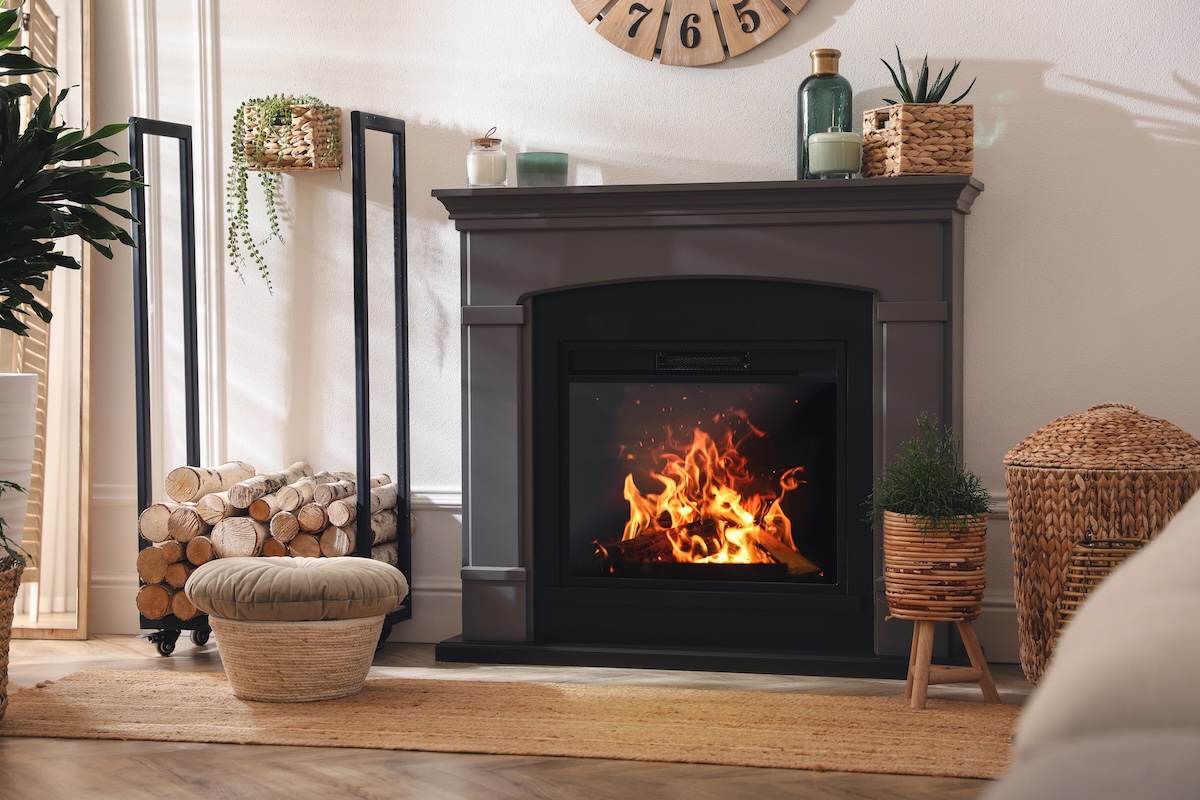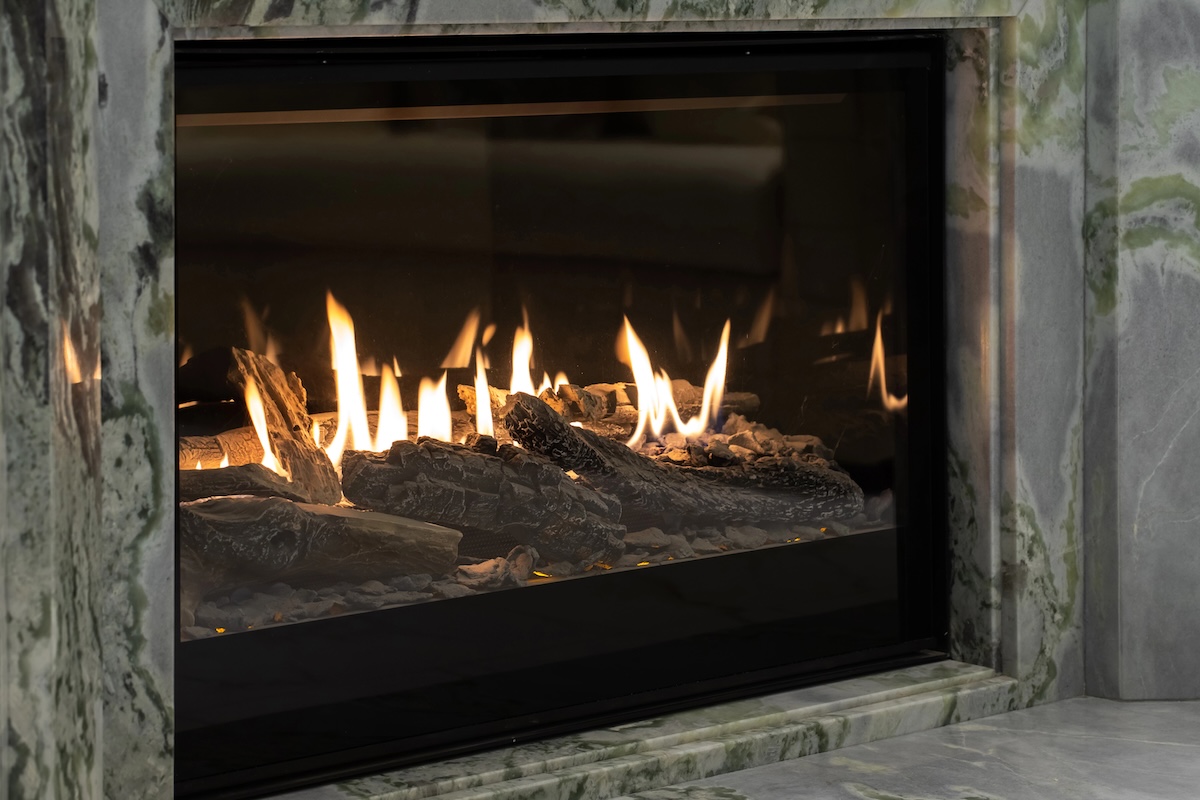

We may earn revenue from the products available on this page and participate in affiliate programs. Learn More ›
A fireplace instantly makes a home feel warmer and more inviting, giving you both physical heat and a relaxing atmosphere. Today, most homeowners considering a fireplace installation are deciding between two main options: gas or electric. Gas fireplaces deliver real flames and stronger heat output, while electric models are typically easier to install, more affordable, and require less maintenance. We asked Keith Wortsmith, the President of DASH Heating & Cooling in Arizona, about the key differences between gas and electric fireplaces. With his insights about their differences in cost, efficiency, appearance, and upkeep, you’ll be better situated to decide which type of fireplace is best for your home.
Installation
Gas Fireplaces
Gas fireplaces offer quick heat and the look of real flames, but they are complicated to install. They require a gas line or propane supply, and often venting to the outside. Wortsmith notes that this isn’t a DIY job: “Hooking up a gas line or venting wrong can be dangerous, that’s why gas fireplaces should always be installed by a professional.” In many cases, installation involves permits, carpentry, and inspections—and can quickly add to the upfront cost.
Electric Fireplaces
Electric fireplaces are far simpler to install. Most units plug into a standard 110-volt outlet, though larger models may need a dedicated circuit. As Wortsmith explains, “Electric fireplaces are a lot easier to install—most of the time you just plug [them] in, or at the most you’ll need an electrician if it’s hardwired.” This makes them an especially appealing retrofit for older homes.
Winner: Electric. Plug-and-play convenience makes these fireplaces easier and less expensive to set up.
Aesthetic Appeal

Gas Fireplaces
Gas fireplaces create real flames and radiant warmth, making them the closest alternative to wood-burning. They look more authentic, with log sets, glowing embers, and customizable styles.
Electric Fireplaces
Electric fireplaces simulate fire with LED lighting, projection, or even water vapor effects. Older models looked artificial, but new technology has made them far more convincing. Many electric fireplaces also let you adjust flame color, brightness, and sound effects to fit the mood.
Our Recommendation: PuraFlame Klaus Electric Fireplace Insert for $429.99.
This PuraFlame model is the top pick in our guide to the best electric fireplaces. The ventless electric fireplace heats up to 400 square feet with realistic glowing logs, dancing flames, and a snapping “fire,” and it comes with a convenient remote control.
Winner: Gas. The real flames and natural ambiance are hard to beat, though high-end electric fireplaces are catching up.
Our Recommendation: Napoleon Grandville VF36-2N 37″ Natural Gas Fireplace for $1,649.
Napoleon’s Grandville is a large gas insert capable of producing 30,000 BTUs of heat, has no loss of heat through a vent or chimney, and an energy efficiency rating of 99 percent or better.
Cost
Gas Fireplaces
Gas fireplaces cost more up front, with the combined cost of unit and installation ranging from $7,200 to $16,200. Ongoing costs include gas or propane, annual inspections, and maintenance. Hidden costs can creep in too: “If it’s a gas fireplace, you need to run a gas line, sometimes you need a vent put in, and depending where you live there’s permits too, and that stuff adds up,” says Wortsmith.
Electric Fireplaces
Electric fireplaces are less expensive, averaging $200 to $2,200, including installation. Most setups cost just $150 to $300, unless wiring or panel upgrades are needed. Operating costs are usually $80 to $131 annually, far below the $412 to $2,708 average for gas.
Winner: Electric. Lower purchase price, simpler installation, and lower annual costs make it the budget-friendly choice.
Energy Efficiency
Gas Fireplaces
Modern, high-quality gas fireplace inserts are far more efficient than older wood-burning ones, with sealed models achieving 70 to 90 percent efficiency. Still, some heat is lost through the vent.
Electric Fireplaces
Electric fireplaces convert 100 percent of the electricity they use into heat, with no venting required. As Wortsmith puts it, “Electric fireplaces are technically 100 percent efficient since all the power turns into heat. Gas loses some through the vent.” Many also feature LED flames and no-heat mode, so you can enjoy the look year-round without extra energy use.
Winner: Electric. Perfect efficiency and flexible flame-only modes give it the edge.
Maintenance
Gas Fireplaces
Gas fireplaces need yearly professional servicing to clean burners, check vents, and ensure safe operation. Wortsmith stresses: “On a gas fireplace, I usually say it’s best to have a tech look at it once a year and clean the burners so the flames don’t get all yellow, check the pilot, and make sure the vent’s not blocked.” Homeowners can keep the glass clean and vacuum around the unit.
Electric Fireplaces
Electric models require little more than dusting, cleaning glass, and occasionally replacing bulbs. There are no vents, burners, or gas lines to worry about.
Winner: Electric. Minimal upkeep makes them the easiest to live with.
Safety

Gas Fireplaces
Gas units are safer than wood-burning, but still pose risks from leaks, carbon monoxide, or improper venting. Long-term exposure to carbon monoxide is dangerous, which is why annual inspections and CO detectors are essential.
Electric Fireplaces
The risks are closer to those of any plug-in appliance. As Wortsmith explains: “With an electric fireplace, the risk isn’t much different than any other thing you plug in the wall. The main hazard is overloading a circuit, damaged cords, or overheating.” Keeping cords intact and not overloading outlets greatly reduces fire hazards.
Winner: Electric. No gas, flame, or emissions makes them the safer bet overall.
Bottom Line
Both gas and electric fireplaces create cozy ambiance and supplemental heat, but they excel in different ways. If you want realistic flames and higher heat output, gas is the way to go. If you prefer lower upfront cost, easy installation, efficiency, and minimal maintenance, electric is the smarter choice.
How to Choose the Right Fireplace for Your Home

The best fireplace for your home depends on your priorities. If you value stronger heat output, the look of real flames, and don’t mind professional installation or annual maintenance, a gas fireplace is worth the investment. If you want something that’s budget-friendly, easy to set up, and nearly maintenance-free, an electric fireplace will likely be the better fit.
Wortsmith sums it up this way: “The standard rule is to choose electric for short turn-ons here and there, and gas if you want to use it daily.”
For homeowners weighing cost, convenience, and safety, an electric fireplace often comes out on top. But for those seeking authenticity and lasting value, gas fireplaces still deliver the closest thing to a traditional fire.
FAQ
It depends. Gas offers more heat and realism, while electric is cheaper, easier to install, and safer.
Yes, most heat about 400 square feet, making them great supplemental heaters for bedrooms, living rooms, or offices.
They produce less heat, rely on electricity, and their flame effects, while improved, still aren’t as authentic as real fire.
They’re more expensive to install, require annual maintenance, and carry risks of leaks, carbon monoxide, or venting issues.
Consider replacing if you want lower maintenance, reduced costs, and easier installation, but expect less heat and realism.
The prices listed here are accurate as of publication on January, 31, 2023.
